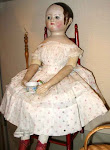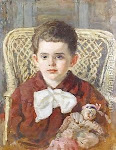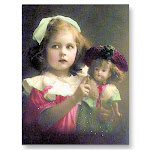 “That which we call a rose…By any other name would smell as sweet."
“That which we call a rose…By any other name would smell as sweet."Shakespeare, Romeo and Juliet.
The dolls is wearing her original costume that includes a knitted hat. Shadow box retains original hand rolled glass front.
ca. 1835-40
 The first mass-produced molded papier mache heads were introduced at Sonneberg Thuringia in the early 19th century. At this time the German toy trade was expanding to embrace a world market. Papier mache heads were used extensively on a body made of fabric or leather, with the characteristic bands of leather neatening the joints of the wooden, or papier mache lower arms and legs.
The first mass-produced molded papier mache heads were introduced at Sonneberg Thuringia in the early 19th century. At this time the German toy trade was expanding to embrace a world market. Papier mache heads were used extensively on a body made of fabric or leather, with the characteristic bands of leather neatening the joints of the wooden, or papier mache lower arms and legs. Milliner's Model Winners at a UFDC Reg. 14 Competitive Exhibit.
Milliner's Model Winners at a UFDC Reg. 14 Competitive Exhibit.Category: Milliner's Model types, or type body.

 Beautiful 17" Kestner Milliner's, wearing a period bonnet of forest green silk velvet, featuring an ostrich plume. The doll's attire is a chintz print, with a rich deep green over cream background. Wonderful styling of the sleeves.
Beautiful 17" Kestner Milliner's, wearing a period bonnet of forest green silk velvet, featuring an ostrich plume. The doll's attire is a chintz print, with a rich deep green over cream background. Wonderful styling of the sleeves.
 Small German Milliner's Model, 7 3/4” perfect in a large scale doll house. Black-painted molded hairstyle, and a white kid leather body with hard-carved wooden arms and legs. Original colorful silk dress and a charming straw hat.
Small German Milliner's Model, 7 3/4” perfect in a large scale doll house. Black-painted molded hairstyle, and a white kid leather body with hard-carved wooden arms and legs. Original colorful silk dress and a charming straw hat. This Papier Mache doll is all original. She can be dated to the end of the first decade of the 1800s. Her hairstyle is the fashion of the late teens and early 1820's with its multiple side curls and its braided top knot. She has painted tendrils along the side of her face. Her body is leather with wood hands and feet attached with paper bands. She is 12 inches tall with her hat .
This Papier Mache doll is all original. She can be dated to the end of the first decade of the 1800s. Her hairstyle is the fashion of the late teens and early 1820's with its multiple side curls and its braided top knot. She has painted tendrils along the side of her face. Her body is leather with wood hands and feet attached with paper bands. She is 12 inches tall with her hat . The origin of the term “Milliner’s Model Doll” has only been speculated about;
The origin of the term “Milliner’s Model Doll” has only been speculated about;“In the twentieth century, Eleanor St. George named this type of doll ‘Milliner's Model’. Her correspondence indicates that this was a name she created without historical documentation or precedent for it." - Coleman
According to St George “The small Milliner’s dolls or Coiffure dolls ranging from sizes 6 to 20 inches, were designed as a dressmaker’s doll, resembling ladies modeling the latest fashions in clothing and coiffures, and were not intended for play. After they had served their fashion purpose, many found their way to the nurseries to serve as play dolls.”
 Classic Milliner's style leather body on an exquisite 10 1/2" doll. Original hand sewn dress featuring Leg o' Mutton sleeves and matching bonnet.
Classic Milliner's style leather body on an exquisite 10 1/2" doll. Original hand sewn dress featuring Leg o' Mutton sleeves and matching bonnet. There is much confusion over the terminology for dolls. According to John Darcy Noble these dolls could never have been used for the purpose of a dressmaker’s model for several reasons:
There is much confusion over the terminology for dolls. According to John Darcy Noble these dolls could never have been used for the purpose of a dressmaker’s model for several reasons:1. They were too small to use as patterns
2. The clothes were not in fact effectively removable for making patterns
3. The dolls themselves are difficult to dress and undress due to the stiff bodies and odd hairstyles
4. There is no record of these dolls being used for this purpose.
 They are also referred to as "Varnished Heads" in the 1829-1833 Day Book of Lewis Page at the Henry Francis du Pont Winterthur Museum, and according to Christiane Grafnitz, the proper term for the Milliner type dolls are German Papier Maches with wooden arms and legs.
They are also referred to as "Varnished Heads" in the 1829-1833 Day Book of Lewis Page at the Henry Francis du Pont Winterthur Museum, and according to Christiane Grafnitz, the proper term for the Milliner type dolls are German Papier Maches with wooden arms and legs.
 "Nina Coultis" ca. mid 1800's... This is a rare 7 1/2" German doll with applied human hair on a painted head. At one time she was part of a museum collection.
"Nina Coultis" ca. mid 1800's... This is a rare 7 1/2" German doll with applied human hair on a painted head. At one time she was part of a museum collection.The name Milliner’s is a misnomer as they were never intended to be hat models, as it is hard to believe how these petite dolls with impossibly elaborate molded hairdos could ever have modeled hats.
Many German dollmakers made Papier Maches that greatly resembled China dolls. Some fashion dolls from the mid-1800s were made in France (predecessors to the later French bisque and china dolls). Later, some of the German Papier Mache dolls resembled their bisque sisters.
I would highly recommend Gregory LeFever’s article: “Milliner’s Models, or Varnished Heads”, on the “Early American Life” magazine issue, of April 2010 on the subject of these dolls. It was a great source of information on creating this post.













































.jpg)









































































Es un placer leer tus articulos
ReplyDeleteThanks!!
Muchas gracias Maria, por tu soporte continuo.
ReplyDeleteHugs!
Es maravilloso, Todo Lo Que nep explicas.
ReplyDeleteNos enseñas muchisimo. Muchas gracias.
Un abrazo Muy Fuerte.
Carmen
Abrazos para ti Carmen. Gracias por tu amable comentario.
ReplyDeleteBesos
Marta
Marta esta información sobre las Milliner’s Models dolls es fabulosa, y las fotos también pues yo tomo ideas para hacer mis trabajos o sea me sirven de inspiración.
ReplyDeleteMuchas gracias Leo. Me alegra mucho que mis articulos te sirvan de inspiracion. A veces pienso que mis post se alargan, pero es dificil escojer solo una o dos entre tantas muñecas bellas.
ReplyDeleteBesos
Marta
Marta,
ReplyDeleteI want one of each of those gorgeous dolls! And the picture of the lil girl with her doll is just so sweet. Thanks for the beautiful pics. Aaaahhh a girl's gotta have her dreams!
You and me both Carol!...if only that was possible. Thank you so much for your sweet comments.
ReplyDeleteBig Hugs
Marta
Thank you, Marta, for mentioning my husband's recent article on said topic. Another thing that I have learned is that the very word milliner used to mean a department store of sorts, because the root of that word is a thousand therefore one can find many things in such a shop. And so, milliner shoppe, as in historic Virginia was not at all to do with hats.
ReplyDeleteI really believe that there is a strong possibility that a doll dressed for a shop window might have simply been modeling the latest fabrics. One never knows!
Hugs,
Zwee!!!!!!
Oh what a wonderful blog! I am a fashion, culture, and history enthusiast who loves to sew and your thoughts and photos made me very happy.
ReplyDeleteI'd been researching the history of true fashion dolls - actually used for promotion of haute couture - when I found this blog. Much appreciation!
Thank you Jennifer, the pleasure is mine. I am so glad my blog is helping you. this is a welcome incentive for me to continue.Tthank you so much for your beautiful commen.t
ReplyDeleteMarta
awesome post!! that is what I was looking for :)
ReplyDeleteThank you! Its always very rewarding when others can benefit from what I love so much.
ReplyDeleteYet another marvelous article! Thanks!
ReplyDeleteI can clear up the milliner question, as I am in fact, a retired milliner. Originally milliner's shops were places one went, sometimes to have a dress made, but very often just to have it trimmed, and perhaps to have matching accessories made. So, you would make a plain dress at home, bring it to your milliner, and she would embellish it. She might also embellish a fabric hat, but more often she would make those from scratch, since hats are made from specialized materials that your average lady would not have at home. Milliners were the first fashion designers.
This has always confused people, because we now use the term "milliner" only to mean one who makes women's hats ( one who makes men's hats is morer plainly called a hat maker). But knowing the association with embellishments, you can probably see how the word evolved now.
Another word that has similarly evolved, is barber. At one time the town barber was also the town surgeon. In fact, the striped barber pole evolved from the
practice of hanging one's bloody towels outside to dry. That charming pole may look like a peppermint stick to us now, but it symbolizes a bloody rag!
Thank you Laurel...That is so interesting about the Barber Shop post! I guess the term "Multi-Tasking" could be applied here..LOL!
ReplyDeleteThank you for the information on Milliners. I have another post " Those Frills Flowers, Buttons and Bows" that covers more of the Milliner's occupation. Check it ou if you have time.
Hugs
Marta